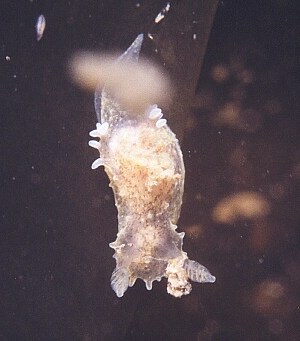
Palio zosterae
(O'Donoghue, 1924)
Order: NUDIBRANCHIA
Suborder: DORIDINA
Superfamily: ANADORIDOIDEA
Family: Polyceridae
Subfamily: Polycerinae
PHOTO
Cates Park, Indian Arm, Burrard Inlet, Vancouver, British Columbia, Canada. Depth: 25 feet, 27 May 2003. Photo: Paul Sim
The background colour is translucent clear with a covering of microscopic brown specks, sometimes sparse, but usually quite dense. Scattered over the body are small raised conical tubercles which lack the brown speckling and can sometimes have microscopic yellow spots. The lamellate rhinophores and tripinnate gills (numbering up to 5) are translucent with a brownish tinge. The frontal margin of the mantle is slightly bilobed and bears a number of rounded pale papillae. The mantle edge is rather indistinct except around the head. Down each side of the body it can be distinguished by a row of small conical papillae which join behind the gill into a median ridge which runs to the posterior tip of the foot. On either side of the gills, and just behind, there are a group of 5-6 white irregularly shaped extra-branchial papillae. The sides of the body are similar in colour to the mantle, the tubercles being lower and rounded in shape. It grows to approx 12mm in length.
O'Donoghue reports this species from the leaves of the sea grass Zostera, hence its name, but it appers to have no biological relationship with Zostera. Gosliner & Williams (1973) report it on the arborescent bryozoan Bowerbankia gracilis and Rivest (1984) collected it commonly on the encrusting bryozoan Membranipora membranacea from the kelp Laminaria sp. Palio zosterae and Palio dubia copulate by hypodermic imjection (Rivest, 1984). The vaginal duct is incomplete, and instead of inserting the penis into the partner's vagina, the penis is first attached to the body wall of its partner by curved hooks, and then a hole is pierced through the body wall. Usually penetration occurs on the right side of the body but it can occur at any point of the body. Only sperm that is injected through the body wall directly into the gonad succeeds in fertilisng the eggs. Sperm that is injected into the body cavity is destroyed by blood cells as foreign material. The biological significance/advantage of hypodermic copulation is unknown.
Although normally placed in the genus Polycera, its general shape and presence of extra-branchial appendages, show that it is more appropriately placed in the genus Palio. Rivest (1984) argues that the differences in reproductive anatomy support the case for considering Palio to be a genus distinct from Polycera. First described from Vancouver Is., Canada, Palio zosterae is now known along the west coast of North America from British Columbia to Bodega Bay, California.
This species is very similar in shape to Palio nothus. If the photo of Palio zosterae in Behrens (1991) is correctly identified, then P. zosterae is almost certainly identical to the Atlantic species P. nothus.
References:
• Baba, K. 1960. The genera Polycera, Palio, Greilada and Thecacera from Japan (Nudibranchia - Polyceridae). Publications of the Seto Marine Biological Laboratory 8(1): 75-78, pl. 6.
• Behrens, D. W. (1991) Pacific coast nudibranchs: a guide to the
opisthobranchs, Alaska to Baja California, 1- 107. Second Edition. Sea Challengers: Monterey, California.
• O'Donoghue, C. H. (1924) Notes on the nudibranchiate Mollusca from the Vancouver Island region. IV. Additional species and records. Transactions of the Royal Canadian Institute, 15(1): 1-33, pls. 1-2.
• Rivest, B. R. 1984. Copulation by hypodermic injection in the nudibranchs Palio zosterae and P. dubia (Gastropoda, Opisthobranchia). Biological Bulletin, 167(3) : 534-554.
• Gosliner, T. M., & G. C. Williams. (1973) The occurrence of Polycera zosterae O'Donoghue, 1924 in the Bodega Bay region, California, with notes on its natural history Gastropoda: Nudibranchia). The Veliger, 15(3): 252-253.
Rudman, W.B., 2003 (July 13) Palio zosterae (O'Donoghue, 1924). [In] Sea Slug Forum. Australian Museum, Sydney. Available from http://www.seaslugforum.net/find/palizost
Related messages
Polycera zosterae from British Columbia
July 16, 2003
From: Paul Sim


Dear Bill,
I noticed you did not have Polycera zosterae in your species list ... so here's one. It was (I think) the only time I've seen this in the 500 or so dives I have done (most in this area). I am led to understand it is not common and although the photo's are not stupendous (vis was under 10 feet and you can see some debris both on the animal and between the lens and the animal), I thought you might like to have them to at least start the listing. David Behrens book, Pacific Coast Nudibranchs has a listing for better details and photo.
Divesite: Cates Park, Indian Arm, Burrard Inlet, Vancouver, British Columbia, Canada
Depth: 25 feet., Water temp: 51 degrees Farenheit. Found on some red blade algae over a silt bottom. 27 May 2003.
Equipment: Nikonos-V 1:1 Fuji Superia 100
Paul Sim
plsim@shaw.ca
Sim, P., 2003 (Jul 16) Polycera zosterae from British Columbia. [Message in] Sea Slug Forum. Australian Museum, Sydney. Available from http://www.seaslugforum.net/find/10392Dear Paul,
Thanks for these photos. We are gradually getting photos of some of these rather small well-camouflaged species which are probably more common than we realise. Both your animal and the one in Dave Behren's book clearly show the white extra-branchial appendages which are characteristic of the genus Palio. Of more interest is that as Bleakney notes, the animal in Dave Behrens' photo is identical in shape and colour to the Atlantic species Palio nothus, which is found on both sides of the north Atlantic.
If your animal and Behrens' are the same species, it would be interesting to know just how much colour variation is found along the west coast of North America, for P. zosterae may turn out to be a Pacific population of Palio nothus.
Best wishes,
Bill Rudman
